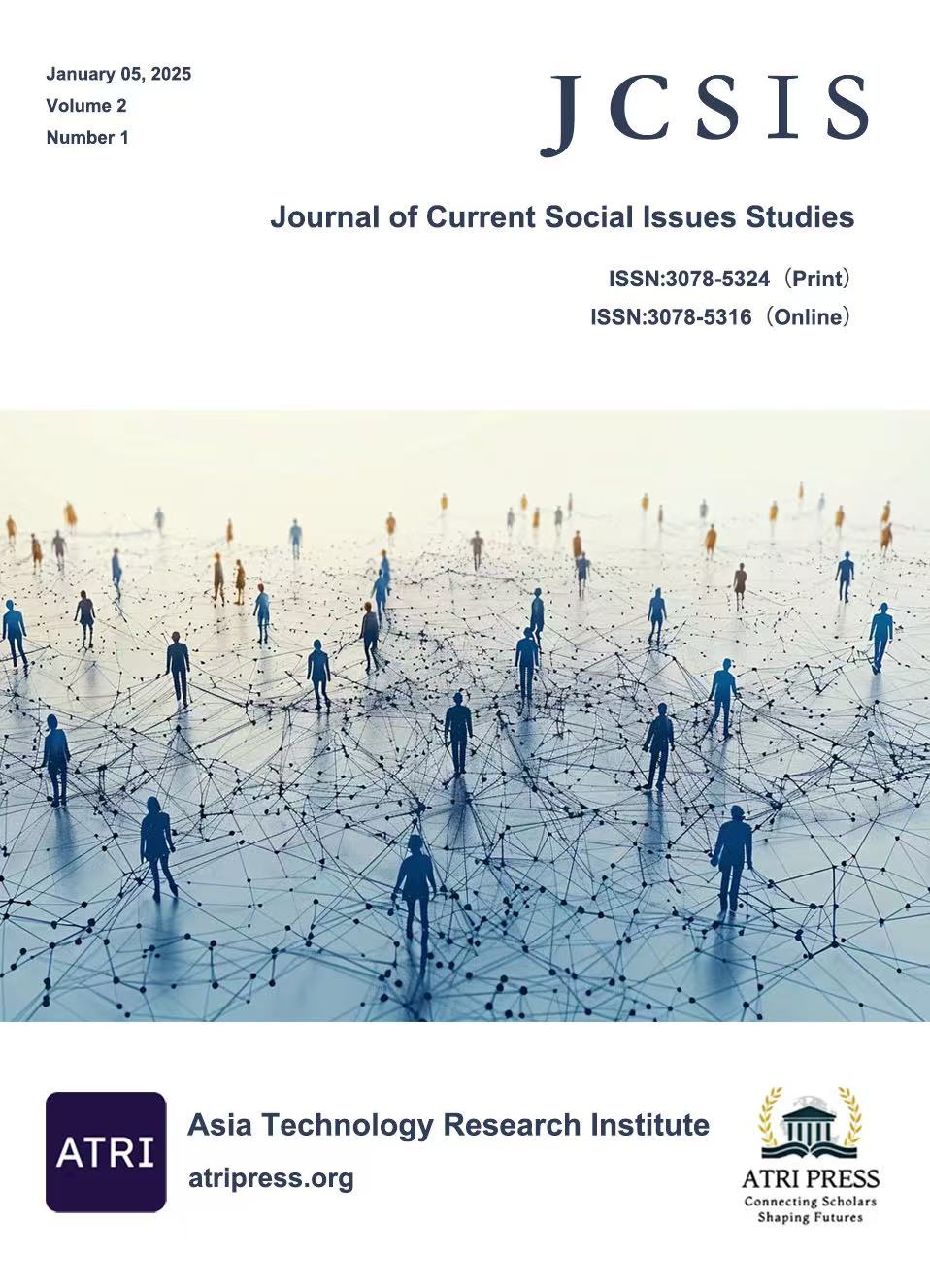Reverse Teacher Questioning Strategy to Enlarge ZPD! ---- A New Approach to Improve Differentiated Classroom
DOI:
https://doi.org/10.71113/JCSIS.2025v2i1.1-18Keywords:
ZPD;Teacher Questioning;DifferentiationAbstract
Differentiated instruction has always been a major challenge for educators, and how to balance the learning tasks of diverse levels of learners is at the top of the list. This research is based on further exploration of the ZPD theory through quantitative analysis of the research methodology and in-depth one-on-one interviews with 12 students from an international high school in Shanghai, China. The research found that learners were not offended by tiered tasks itself, but they were offended by being assigned different tiers of tasks by their teachers and expected that they would have the choice of different learning tasks. For learning tasks, learners prefer more challenging tasks, and the reverse teacher questioning strategy, i.e. ‘hard-to-easy’ teacher questioning strategy, can effectively help learners to develop the ability to solve complex tasks. This constructed learning ability effectively teaches learners to ask questions, understand questions, analyse questions, and solve them. This ability can contribute to expanding the ZPD of learners with different abilities and narrowing the ability gap in a mixed-ability classroom.
Downloads
References
[1]Al Riyami, T. (2015). Main approaches to educational research. International Journal of Innovation and Research in Educational Sciences, 2(5), 412-416.
[2]Anderson, L.W. et al. (2001) A taxonomy for learning, teaching, and assessing: A revision of Bloom's Taxonomy of Educational Objectives. New York ; San Francisco ; Boston: Longman.
[3]Bellil, N. (2020). Communicative sessions in mixed-abilities classroom: The Big Challenge for Low Achievers. Journal of English Language Teaching and Applied Linguistics, 2(5), 61–75. https://doi.org/10.32996/jeltal.2020.2.5.7
[4]Berinsky, A. J. (2006). American public opinion in the 1930s and 1940s: The analysis of quota-controlled sample survey data. Public Opinion Quarterly, 70(4), 499–529. https://doi.org/10.1093/poq/nfl021
[5]Bloom, B.S., 1968. Learning for Mastery. Instruction and Curriculum. Regional Education Laboratory for the Carolinas and Virginia, Topical Papers and Reprints, Number 1. Evaluation comment, 1(2), n2.
[6]Bodrova, E., & Leong, D. (2024). Tools of the mind: The Vygotskian approach to early childhood education. Taylor & Francis.
[7]Brough, C. J. (2012). Implementing the democratic principles and practices of student‐centred curriculum integration in primary schools. The Curriculum Journal, 23(3), 345–369. https://doi.org/10.1080/09585176.2012.703498
[8]Brown, J., A. Collins, and P. Duguid. "Situated cognition and the culture of Learning." Psychology of Education: Major Themes: Pupils and Learning 2 (2000): 207-230.
[9]Calder, N. (2015). Student wonderings: Scaffolding student understanding within student-centred inquiry learning. ZDM, 47(7), 1121–1131. https://doi.org/10.1007/s11858-015-0734-z
[10]Carroll, J. B. (1963). A Model of School Learning. Teachers College Record: The Voice of Scholarship in Education, 64(8), 1–9. https://doi.org/10.1177/016146816306400801
[11]Creswell, J. W., & Tashakkori, A. (2007). Editorial: Differing perspectives on mixed methods research. Journal of Mixed Methods Research, 1(4), 303–308. https://doi.org/10.1177/1558689807306132
[12]Davis, E. A., & Miyake, N. (2004). Explorations of Scaffolding in Complex Classroom Systems. Journal of the Learning Sciences, 13(3), 265–272. https://doi.org/10.1207/s15327809jls1303_1
[13]Denzin, N. K., & Lincoln, Y. S. (2003). Strategies of qualitative inquiry. Sage, Thousand Oaks, CA.
[14]Donnelly, D. F., McGarr, O., & O’Reilly, J. (2014). ‘Just Be Quiet and Listen to Exactly What He’s Saying’: Conceptualising power relations in inquiry-oriented classrooms. International Journal of Science Education, 36(12), 2029–2054. https://doi.org/10.1080/09500693.2014.889867
[15]Dweck, C. S. (2006). Mindset: The new psychology of success. Random house.
[16]Eikeland, I., & Ohna, S. E. (2022). Differentiation in education: A Configurative Review. Nordic Journal of Studies in Educational Policy, 8(3), 157–170. https://doi.org/10.1080/20020317.2022.2039351
[17]Eun, B. (2019). The zone of proximal development as an overarching concept: A framework for synthesizing Vygotsky’s theories. Educational Philosophy and Theory, 51(1), 18–30. https://doi.org/10.1080/00131857.2017.1421941
[18]Fraser, D. (2000). Curriculum integration: What it is and is not. Set: Research Information for Teachers, 3, 34–37. https://doi.org/10.18296/set.0780
[19]Gardner, H., 1983. Frames of Mind: A Theory of Multiple Intelligences. New York: Basic Books.
[20]Gschwend, T. (2005). Analyzing quota sample data and the peer-review process. French Politics, 3(1), 88–91. https://doi.org/10.1057/palgrave.fp.8200068
[21]Hammersley, M. (2013). What Is Qualitative Research? https://doi.org/10.5040/9781849666084
[22]Hamre, B. K., & Pianta, R. C. (2005b). Can instructional and emotional support in the first‐grade classroom make a difference for children at risk of school failure? Child Development, 76(5), 949–967. https://doi.org/10.1111/j.1467-8624.2005.00889.x
[23]Hanewicz, C., Platt, A., & Arendt, A. (2017). Creating a learner-centered teaching environment using student choice in assignments. Distance Education, 38(3), 273–287. https://doi.org/10.1080/01587919.2017.1369349
[24]Harlen, W. (2001). Primary science: Taking the plunge. How to teach science more effectively for ages 5 to 12. Heinemann, 361 Hanover Street, Portsmouth, NH 03801-3912.
[25]Heritage, M., & Heritage, J. (2013). Teacher Questioning: The Epicenter of Instruction and Assessment. Applied Measurement in Education, 26(3), 176–190. https://doi.org/10.1080/08957347.2013.793190
[26]Hordiienko, N. M., & Lomakina, L. V. (2015b). Teaching EFL to mixed-ability classes: Strategies, challenges, solutions. Advanced Education, 0(3), 39–43. https://doi.org/10.20535/2410-8286.44198
[27]Hussin, S. (2024). Creating a Bigger Z. P. D. for ESL Learners via Online Forum in Malaysia. College Teaching Methods & Styles Journal, 4(11), 1–10. https://eric.ed.gov/?id=EJ967716
[28]Ireson, J., & Hallam, S. (2001). Ability Grouping in Education. https://doi.org/10.4135/9781446221020
[29]Ireson, J., Hallam, S., & Hurley, C. (2005). What are the effects of ability grouping on GCSE attainment? British Educational Research Journal, 31(4), 443–458. https://doi.org/10.1080/01411920500148663
[30]J. Scattergood, A. (2024). The impact of a school ability banding system on white, working-class males. British Journal of Sociology of Education, 1–21. https://doi.org/10.1080/01425692.2024.2315123
[31]Jiang, Y., Wu, Y., Sha, X., & Xu, Y. (2022). The ZPD Perspective on Teachers’ Question-Answer Strategies In Mathematics Classroom. Highlights in Business, Economics and Management, 4, 292–298. https://doi.org/10.54097/hbem.v4i.3506
[32]Junjie, M., & Yingxin, M. (2022). The discussions of positivism and interpretivism. Global Academic Journal of Humanities and Social Sciences, 4(1), 10–14. https://doi.org/10.36348/gajhss.2022.v04i01.002
[33]Kanevsky, L. (2011). Deferential Differentiation: What Types of Differentiation Do Students Want? Gifted Child Quarterly, 55(4), 279–299. https://doi.org/10.1177/0016986211422098
[34]Kitzinger, J. (1994). The methodology of focus groups: The importance of interaction between research participants. Sociology of Health & Illness, 16(1), 103–121. https://doi.org/10.1111/1467-9566.ep11347023
[35]Larina, G., & Markina, V. (2019). Hidden mechanisms of differentiation: Teachers’ beliefs about student diversity. Journal of Mathematics Teacher Education, 23(5), 463–482. https://doi.org/10.1007/s10857-019-09436-1
[36]Levy, H. M. (2008). Meeting the needs of all students through differentiated instruction: Helping every child reach and exceed standards. The Clearing House: A Journal of Educational Strategies, Issues and Ideas, 81(4), 161–164. https://doi.org/10.3200/tchs.81.4.161-164
[37]Litosseliti, L. (2018). Critical perspectives on using interviews and focus groups. Research Methods in Linguistics. https://doi.org/10.5040/9781350043466.ch-009
[38]Logan, B. (2011). Examining differentiated instruction: Teachers respond. Research in higher education journal, 13.
[39]Magableh, I. S., & Abdullah, A. (2021). The impact of differentiated instruction on students’ reading comprehension attainment in mixed-ability classrooms. Interchange, 52(2), 255–272. https://doi.org/10.1007/s10780-021-09427-3
[40]Martin-Beltrán, M., Guzman, N. L., & Chen, P.-J. J. (2017). ‘let’s think about it together:’ how teachers differentiate discourse to mediate collaboration among linguistically diverse students. Language Awareness, 26(1), 41–58. https://doi.org/10.1080/09658416.2016.1278221
[41]Mehri Kamrood, A., Davoudi, M., Ghaniabadi, S., & Amirian, S. M. (2019). Diagnosing L2 learners’ development through online computerized dynamic assessment. Computer Assisted Language Learning, 34(7), 868–897. https://doi.org/10.1080/09588221.2019.1645181
[42]Mills, M., Monk, S., Keddie, A., Renshaw, P., Christie, P., Geelan, D., & Gowlett, C. (2014). Differentiated learning: From policy to classroom. Oxford Review of Education, 40(3), 331–348. https://doi.org/10.1080/03054985.2014.911725
[43]Moon, T. R. (2005). The role of assessment in differentiation. Theory Into Practice, 44(3), 226–233. https://doi.org/10.1207/s15430421tip4403_7
[44]Morgan, D. L. (1996). Focus Groups. Annual Review of Sociology, 22(1), 129–152. https://doi.org/10.1146/annurev.soc.22.1.129
[45]Morgan, H. (2014). Maximizing student success with differentiated learning. The Clearing House: A Journal of Educational Strategies, Issues and Ideas, 87(1), 34–38. https://doi.org/10.1080/00098655.2013.832130
[46]Moustakas, C. (1994). Phenomenological Research Methods. https://doi.org/10.4135/9781412995658
[47]Pham, H. L. (2012). Differentiated Instruction and The Need To Integrate Teaching And Practice. Core.ac.uk, 9(1). https://core.ac.uk/reader/268111140
[48]Rajeh Alsalhi, N., Abdelrahman, R., F. I. Abdelkader, A., Salim Al-Yatim, S., Habboush, M., & Al Qawasmi, A. (2021). Impact of using the differentiated instruction (DI) strategy on Student Achievement in an intermediate stage science course. International Journal of Emerging Technologies in Learning (iJET), 16(11), 25. https://doi.org/10.3991/ijet.v16i11.22303
[49]Reiser, B. J. (2004). Scaffolding complex learning: The mechanisms of structuring and problematizing student work. Journal of the Learning Sciences, 13(3), 273–304. https://doi.org/10.1207/s15327809jls1303_2
[50]Robinson, L., Maldonado, N., & Whaley, J. (2014). Perceptions about Implementation of Differentiated Instruction. Online Submission.
[51]Roller, M. R., & Lavrakas, P. J. (2018). A total quality framework approach to sharing qualitative research data: Comment on Dubois et al. (2018). Qualitative Psychology, 5(3), 394–401. https://doi.org/10.1037/qup0000081
[52]Saunders, M., Lewis, P., & Thornhill, A. (2012). Research methods for business students. Pearson.
[53]Schmoker, M. (2010). When pedagogic fads trump priorities. Education Week, 30(5), 22-23.
[54]Suprayogi, M. N., Valcke, M., & Godwin, R. (2017). Teachers and their implementation of differentiated instruction in the classroom. Teaching and Teacher Education, 67, 291–301. https://doi.org/10.1016/j.tate.2017.06.020
[55]Tomlinson, C. A. (2001). How to differentiate instruction in mixed-ability classrooms. Pearson.
[56]Tomlinson, C. A. (2003). Fulfilling the promise of the differentiated classroom: Strategies and tools for responsive teaching. Association for Supervision and Curriculum Development.
[57]Tomlinson, C. A., & Moon, T. (2014). Assessment in a differentiated classroom. Proven Programs in Education: Classroom Management & Assessment, 1–5. https://doi.org/10.4135/9781483365633.n1
[58]Tsiplakides, I. (2018). Differentiation in higher education: The impact of parental education. Social Sciences, 7(2), 28. https://doi.org/10.3390/socsci7020028
[59]Valiandes, S. (2015). Evaluating the impact of differentiated instruction on literacy and reading in mixed ability classrooms: Quality and equity dimensions of Education Effectiveness. Studies in Educational Evaluation, 45, 17–26. https://doi.org/10.1016/j.stueduc.2015.02.005
[60]van Compernolle, R. A., & Williams, L. (2013). Group Dynamics in the language classroom: Embodied participation as active reception in the collective zone of proximal development. Classroom Discourse, 4(1), 42–62. https://doi.org/10.1080/19463014.2013.779284
[61]van Geel, M., Keuning, T., Frèrejean, J., Dolmans, D., van Merriënboer, J., & Visscher, A. J. (2018). Capturing the complexity of differentiated instruction. School Effectiveness and School Improvement, 30(1), 51–67. https://doi.org/10.1080/09243453.2018.1539013
[62]Vehkakoski, T. M. (2012). ‘More homework for me, too’. Meanings of differentiation constructed by elementary-aged students in classroom interaction. European Journal of Special Needs Education, 27(2), 157–170. https://doi.org/10.1080/08856257.2011.645586
[63]Vygotsky, L. S., & Cole, M. (1978). Mind in society: Development of higher psychological processes. Harvard university press.
[64]Vygotsky, L. S. (1997). The History of the Development of Higher Mental Funkctions.
[65]Wass, R., & Golding, C. (2014). Sharpening a tool for teaching: The zone of proximal development. Teaching in Higher Education, 19(6), 671–684. https://doi.org/10.1080/13562517.2014.901958
[66]Wass, R., Harland, T., & Mercer, A. (2011). Scaffolding critical thinking in the zone of proximal development. Higher Education Research & Development, 30(3), 317–328. https://doi.org/10.1080/07294360.2010.489237
[67]Yang, K., & Banamah, A. (2014). Quota sampling as an alternative to probability sampling? an experimental study. Sociological Research Online, 19(1), 56–66. https://doi.org/10.5153/sro.3199
[68]Yaroshevsky, M., 1989. Lev Vygotsky. Moscow: Progress Publishers.
[69]Zhang, W., & Bray, M. (2017). Equalising schooling, unequalising private supplementary tutoring: Access and tracking through shadow education in China. Oxford Review of Education, 44(2), 221–238. https://doi.org/10.1080/03054985.2017.1389710
[70]Zuraidah Nasution, & Syafrina Prihatini. (2024). Improving students’ interaction and motivation by teachers’ questioning strategies. MIMBAR ADMINISTRASI FISIP UNTAG Semarang, 19(2), 103–120. https://doi.org/10.56444/mia.v19i2.1333
Downloads
Published
How to Cite
Issue
Section
License
Copyright (c) 2025 Yunuo Feng

This work is licensed under a Creative Commons Attribution 4.0 International License.























